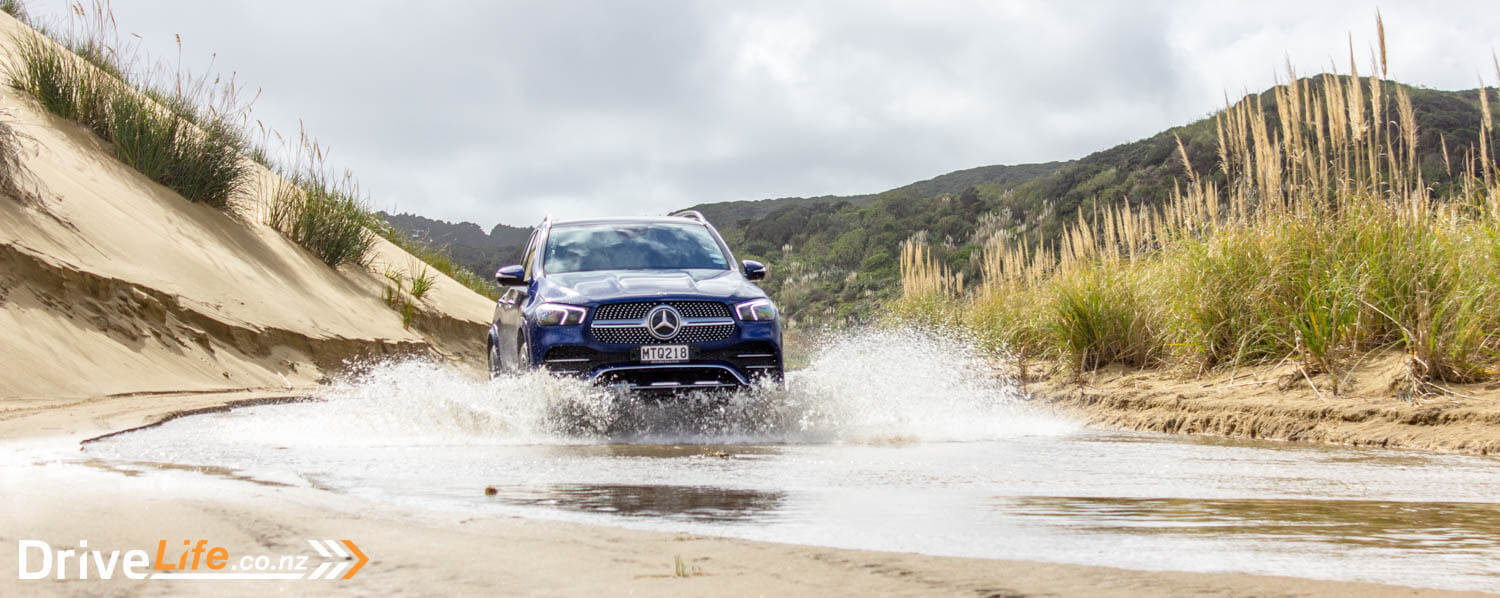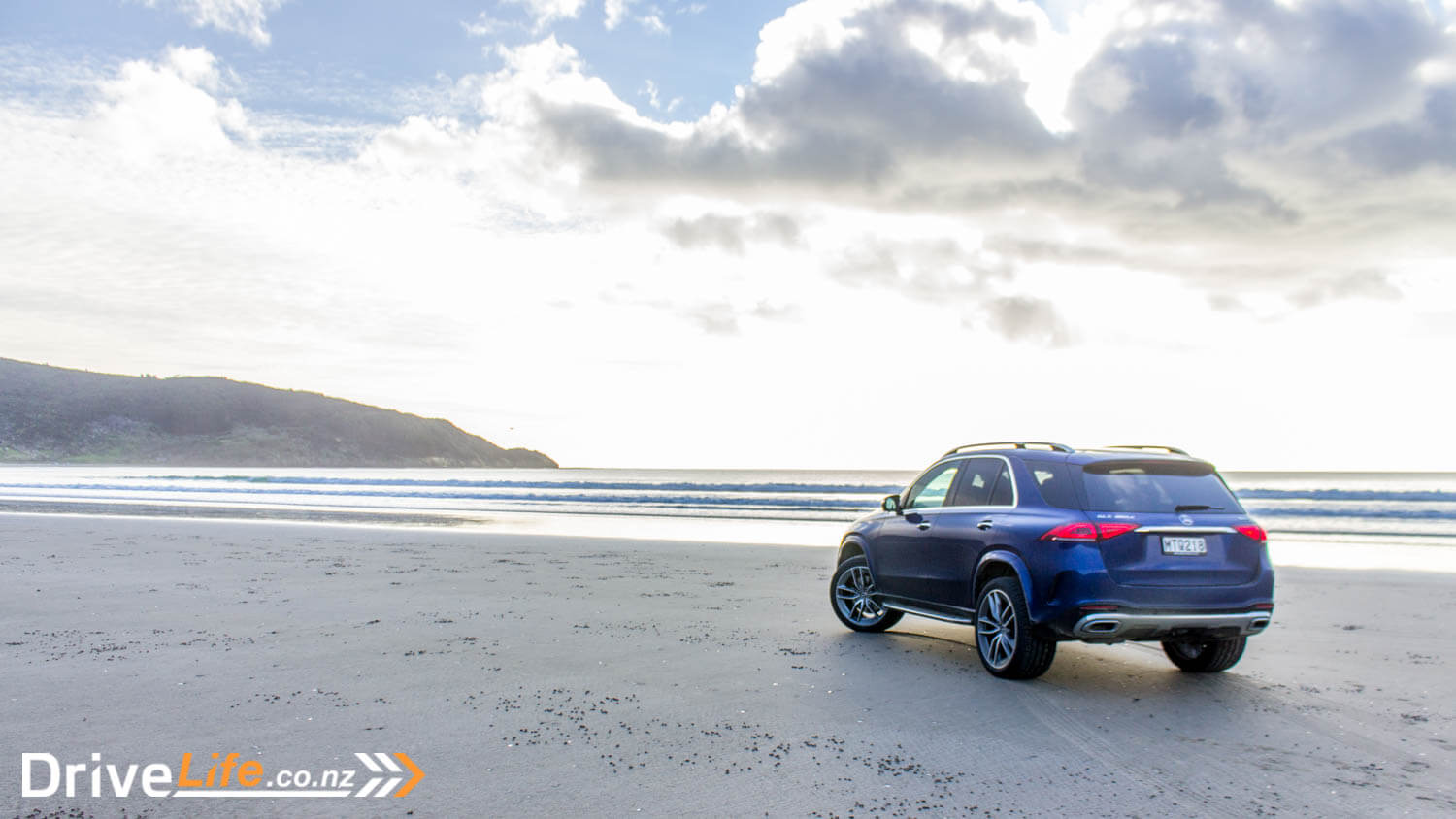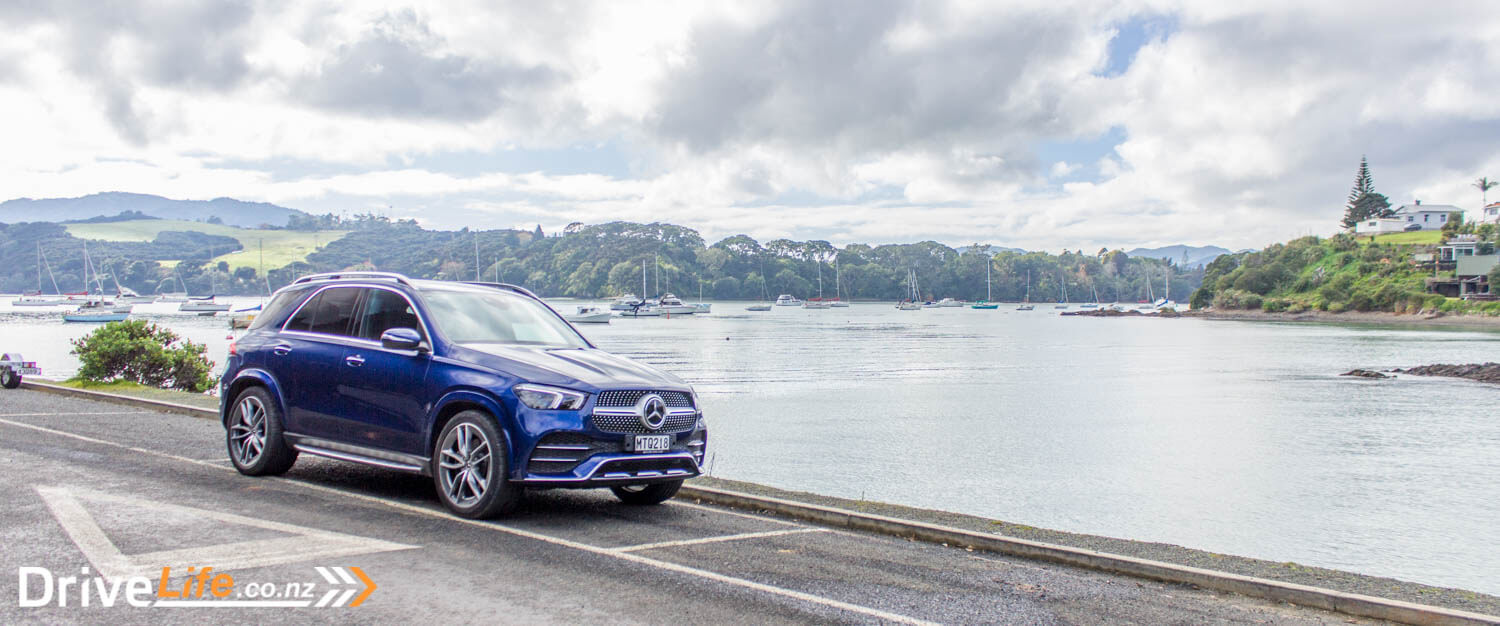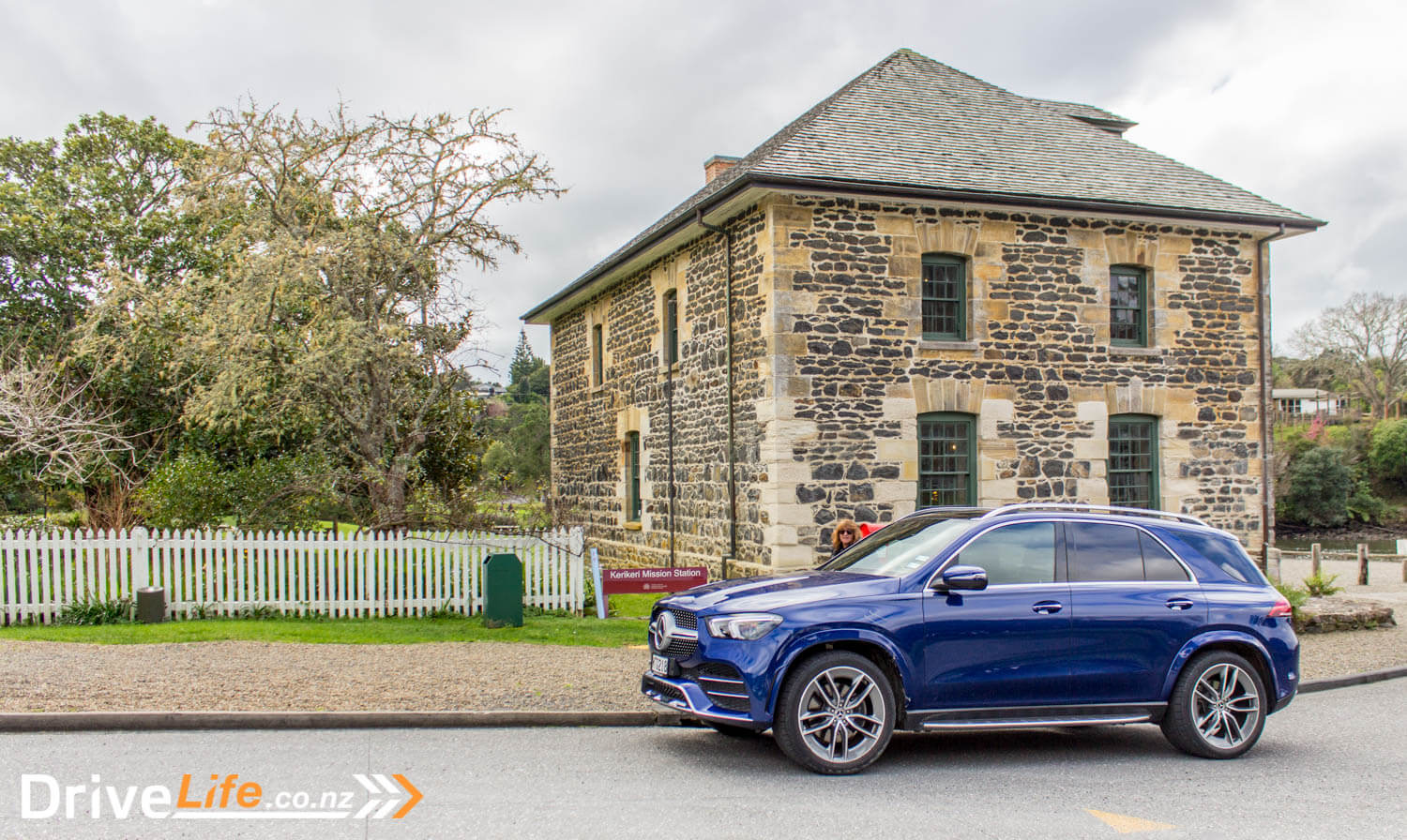When we review a car here at DriveLife, generally we simply use the car as we would our Daily Driver. Do the commute, do the shopping, do the soccer run.
Unless we are taking lots of people and stuff with us, we don’t get to load the cars up to see how they perform with a decent amount of weight on board. So it’s nice to use a test car in another way, like taking it away on holiday.
With a trip away to the Far North planned, we got offered a Mercedes-Benz GLE 300d to use. After reviewing this model in 2019, I loved it and gave it a full 5-chevron rating. Surely this would be the perfect holiday wagon for 5 adults, and all the stuff you end up taking away with you (but never use).

A quick flight to Auckland, and we picked up the 300d – finished in Brilliant Blue Metallic, and even in the dark, it looked stunning. My fears of being given a grey or silver 300d were gone. I know, I know, it’s not all about the colour, but with so many grey and silver cars on our roads, I’m over them, and that’s not even going into the safety factor; grey and silver cars are harder to see on the road.
Our car was fitted with optional ($2000) 22-inch rims; they looked superb, and were fitted with Pirelli P Zero tyres. It would be good to see how these go doing some light off-roading to our bach.
We lowered the rear suspension down using the button in the boot, and loaded up our 5 suitcases and other bags – but could still pull the sliding cover over them – then went to our overnight accommodation.

WEDNESDAY – AUCKLAND TO AHIPARA
Wednesday morning, time to hit the road after a good breakfast. Navigating through Auckland’s rush-hour traffic, I have to say the GLE felt huge in its lane. I was wondering how it was going to cope going off road to our bach in the Far North. That 2-litre, four-cylinder diesel engine instantly brought back memories – so quiet, and even with 5 people and all our stuff on board, still plenty grunty enough for overtaking maneuvers, with 180kW of power and 500Nm of torque.
It was a cold Auckland morning, and front seat passengers were using the heated seats, and while this was one time I missed having a heated steering wheel, I’d push through it. Stuck in traffic, I adjusted the two 12.3” displays to my liking, and slipped my water bottle into the door. After a short time, the bottle started rattling in the door while we were on the move. The door pockets aren’t felt lined, and this would have made all the difference. A small thing, but not quite in keeping with a $150,000+ car.

Rear seat passengers settled in for the 5-hour drive to Kaitaia. With Mangamuka Gorge closed due to a slip, we’d be taking the Highway 10 route past Kerikeri, which is a longer journey. There’s plenty of legroom back there, and two USB-C ports for charging phones. There’s another 2 USB-C ports right up front, and one in the centre cubby. There is one USB-C to USB adapter, so people with ‘normal’ USB ports can still charge. I used the wireless charging pad up front for my iPhone. The pad is nicely angled so your phone doesn’t slide about in the slightest while charging, as can happen on other cars.
Crawling through more traffic, I appreciate again how the centre display comes on with its 360-degree camera when you get too close to another car, or another object. It’s touches like this that make driving that little bit safer.
Finally, we got to our official starting point, the Auckland Harbour Bridge. There’s no reason for this other than it makes for a great photo opportunity. Photos done, we hit the road to head up onto the bridge, turned on adaptive cruise control, and relaxed. I showed my passengers how you can do automatic lane changes in the GLE – with adaptive cruise on, just hit the indicator for the direction you want to change lanes into, and when a gap opens up, the GLE will move over for you. I don’t actually use this feature in normal driving, but I’m sure there are drivers out there who would like it.

We continued north towards Whangarei. I love the heads-up display on this car; there’s three main panels, and you get to choose what you want to display in each one. It’s a bit fiddly to select what you want, but once set, that’s it. I kept the current speed limit on the right hand panel (since safe driving is only about speed, right?), the current speed in the centre, and the gradient and roll angle of the car on the left panel. I noticed on the harbour bridge that gradient got to 9 degrees, so I’d be interested to see what it would get to on the ‘road’ to our bach in Ahipara, in the Far North.
Since traffic was surprisingly light, I made extensive use of the car’s adaptive cruise control. I know I said this about the A Class as well – the GPS-based adjustment of speed on the corners is a great idea, but it’s bordering on taking things too slowly, for me. In a nutshell this is how it works; the car uses GPS tracking, so if you are using adaptive cruise control and the car knows there’s a corner coming up, it will slow down for the corner. This is a great idea, as normally if you have your cruise set to say 100km/h, it does that everywhere, even on tight corners. This can freak some drivers out.
But for me it’s too safe. It slows down too much, for example going down to 80km/h on a corner that can easily be taken at 100km/h. I love the concept, but I wish there was a per-driver menu setting to let me select from options like Slower, Medium, Faster, for this GPS tracked adaptive cruise control. However, you can turn GPS tracking off, and that’s what I did.

As we headed more north, almost to the Kerikeri turn off, a friend messaged to say it’s actually quicker to turn left at Mangamuka township, and get to Kaitaia via Broadwood. A great idea, and not one I had thought of. So we passed the Kerikeri/highway 10 turnoff, and kept going north on Highway One.
There was little traffic on the road, and this part of the drive was a breeze. The road to Broadwood from Mangamuka is pretty gnarly, with lots of turns and dips. I love it, but my wife, not so much. Switching the car into Sport mode stiffened everything up, and I managed to have a bit of fun on that road, without being told to slow down. In Sport mode, the GLE can be thrown around the corners quite nicely, and it revels in a slow in/fast out approach. The grip from all-wheel-drive and that massive rear Pirelli P-Zero tyres (325mm wide) is amazing, and I think if you lost grip you’d be in a whole lot of trouble, as you’d have to be going at an insane speed.
We got to Kaitaia faster than expected, and headed to the supermarket to spend a fortune, stocking up on food for a week. Next, it was time to head to our bach. The trip to Ahipara from Kaitaia only takes 20 minutes, but it’s another 25 minutes to our house, firstly on a metal road and then some metal/some mud. This isn’t the normal place you’d take a $157,000 Mercedes-Benz GLE, but I felt confident it would do just fine.

Hitting the metal road, I stuck the car into Offroad mode, mostly to soften the suspension for all the ruts in the road. It did pretty well. Lots of cars will skip across a rutted corner, but the GLE held its line.
Next up, it was time to go off the public ‘road’ and head to our house. The road narrowed, as I dodged gorse and tea tree to save the paint. Again, the GLE did very well, even with all the weight in the car. This is a heavy car already at 2,261Kg, so going through some mud should have seen it sliding a little, especially with those hugely wide performance tyres, but it didn’t seem to lose grip and slide at any point. After getting through our gate, it was time to go up The Big Hill. While this hill is mostly metaled, it’s bloody steep. I keep an eye on the gradient, and halfway up it hits 31 degrees. That’s a lot more than Auckland Harbour Bridge.

The GLE simply cruises up that hill with no drama and no wheel spin. No doubt all the electronics are helping here. After driving through more muddy puddles and tipping the car over at weird angles, we arrive at our bach. It’s taken a while with all the toilet and food stops, but none of us are feeling tired out. The GLE has done us proud.

MONDAY
After a few days at the bach, it was time to take a trip to Cape Reinga. Heading away early, we had to be back in Kaitaia for a meeting at 2pm, so that didn’t leave a lot of time.

But I didn’t take into account COVID. With almost no traffic on the road, it meant progress wasn’t held up with slow tourists. With lots of twisty corners and the GLE in Sport mode, it ate up each and every corner, with very little body roll. For such a tall SUV, it handles brilliantly. Ride too is a highlight – smooth on all surfaces. Even on the road to our ‘house’, it rides well.

We passed Houhora (quiet), Te Kao (quiet), but the kicker for me was Waitiki Landing. Normally, this place is pumping with traffic any time of the day. The last time we were here, we had to queue to buy food. Today? An empty car park and empty gas station. It was quite a startling sight.


The trip to the Cape was quick and effortless, and we arrived to find a car park with the least amount of cars I’d ever seen. Even at the lighthouse itself, there were only a handful of people. While I really feel for the business relying on overseas tourists, it does make for a much more pleasant visit. If ever there was a time to do a roadie in New Zealand, this is it. No queues, no traffic.

Heading back south, we took a right turn off Highway One to go to Te Paki Stream. We had a visitor with us who had never been to the Far North, so a trip down the stream and then 90 Mile Beach felt like a legal requirement. It was the same scenario at Te Paki Stream – no cars, and we could only see two people on the giant sand dunes. Normally, there’d be dozens climbing up or sliding down.

Heading onto the stream was stress-free in the GLE, although I did switch it to Offroad mode to raise the suspension up, just in case. I did not want to be the one ringing Mercedes Benz NZ to tell them about their stuck GLE. I needn’t have worried though, as with those huge front and rear tyres, there was never a time when we felt we were going to get stuck, or get into any sort of trouble.

Getting to the end of the stream, we turned left and onto 90 Mile Beach (which as we all know, is only 55 miles long). With the tide out, there was plenty of hard-packed sand to stay on, meaning we could easily maintain 100km/h, while looking out for any soft spots or stream crossings. I have to say, we didn’t pass many cars – maybe 4 – in the entire one-hour drive down the beach, but you could see them all thinking the same thing: stolen Mercedes. No one expects a $157,000 Mercedes-Benz to be driven down 90 Mile Beach, but it did it easily and in style. In comfort too, as I had my hot-shoulder massage working my upper body while we drove.

Again, those wide Pirelli P Zero tyres helped on the sand, allowing us to float across it.
Taking the off-ramp at Waipapakauri, we headed back onto State Highway One, which felt a lot more boring than driving on the beach.
We got back to Kaitaia and eventually headed back home to Ahipara, with only a day left to relax, before the 6-hour drive back to Auckland.


WEDNESDAY – AHIPARA TO AUCKLAND
We’re aiming for an easy drive today. With the lack of tourist traffic on the roads, it should be a quick trip to Auckland. We’ve decided to go via State Highway 10 and Kerikeri this time, just for a change of scenery.

After packing up, it was a trip back to Kaitaia first, to get a coffee for the road. A family tradition for us – coffee while driving is the signal of a true road trip.
We headed north to Awanui, then took the Highway 10 turn towards Kerikeri. It was a repeat of Monday – very little traffic. As you do, we stopped in at Mangonui Fish Shop for an early lunch. Another tradition, and you know you will always get the best, freshest fish and nicest chips here, where they’ve been trading since the 1950s. There were plenty of seats in this famous fish shop that is normally bustling with tourists at any time of the day.


Lunch done, it’s back on the road. The GLE ate the miles up on the return trip to Auckland, getting us there in comfort. Again we made the most of the massaging seats; it’s going to be hard to go back to any car without them.


So that was it, we’d driven 1,200Km, and used diesel at a rate of 9.2L/100Km. I didn’t feel that was bad at all, since most of the drive we were fully loaded with people and gear, and going off-road always uses up a heap more fuel, as did driving down 90 Mile Beach. You can feel the drag on the car even when driving on hard-packed sand.

And before anyone jumps up in arms – okay, it wasn’t true off-roading. I wouldn’t consider taking the GLE 300d to a completely muddy track (it’s not my car, after all), but even when the going got a little bit tough for us, the car still surprised with the amount of traction it could get – even with massive Pirelli performance tyres. It shows just how much an impact modern electronics can have on a car’s ability to do something out of the ordinary.
Would most GLE buyers take the car to places like we did? I expect not. We’re probably the first and last to drive a new GLE down Te Paki Stream, but the car did it so easily it was ridiculous.
So the bottom line is that the GLE 300d wasn’t made for the types of roads and tracks we took it on, but it sure can cope with them just fine. I’d take it on that Far North Adventure again in a heartbeat.













































